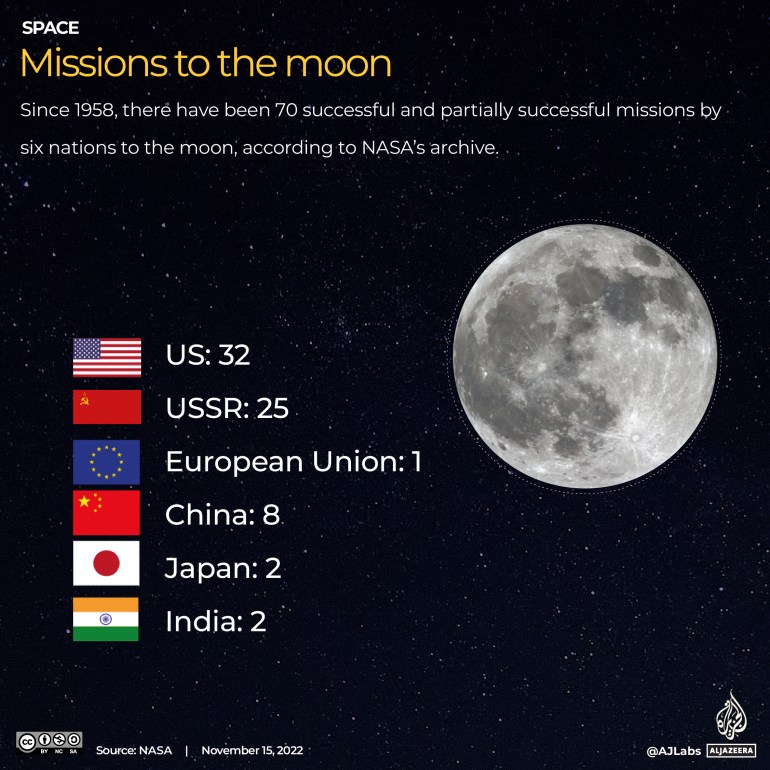What is NASA’s Artemis moon mission and when will it launch?
Artemis I is the first stage of NASA’s new lunar exploration programme, which aims ultimately to establish a long-term presence on the moon’s surface.

More than 50 years after the Apollo moon landing, NASA is getting ready to go back.
The Artemis I mission is scheduled to make its third launch attempt from the Kennedy Space Center in the US state of Florida in the early hours of Wednesday, November 16, following delays due to engine issues, leaks and hurricanes.
Keep reading
list of 3 itemsNASA delays astronaut moon landing to 2025 at earliest
Mapping Mars: 7 graphics to help you understand the Red Planet
NASA hopes to launch the Artemis I rocket during a two-hour window that opens at 1:04am EST (6:04am GMT). The launch will be viewable live on YouTube.
The latest attempt comes after two scrubbed liftoffs due to technical difficulties and a pair of hurricanes walloping Florida over the past month.
Artemis I is the first stage of NASA’s new lunar exploration programme, which has the ultimate goal of establishing a long-term presence on the moon’s surface. It will use the most powerful rocket NASA has ever produced to propel the unmanned Orion spacecraft to the moon at a speed of 39,400km/h (24,500mph).
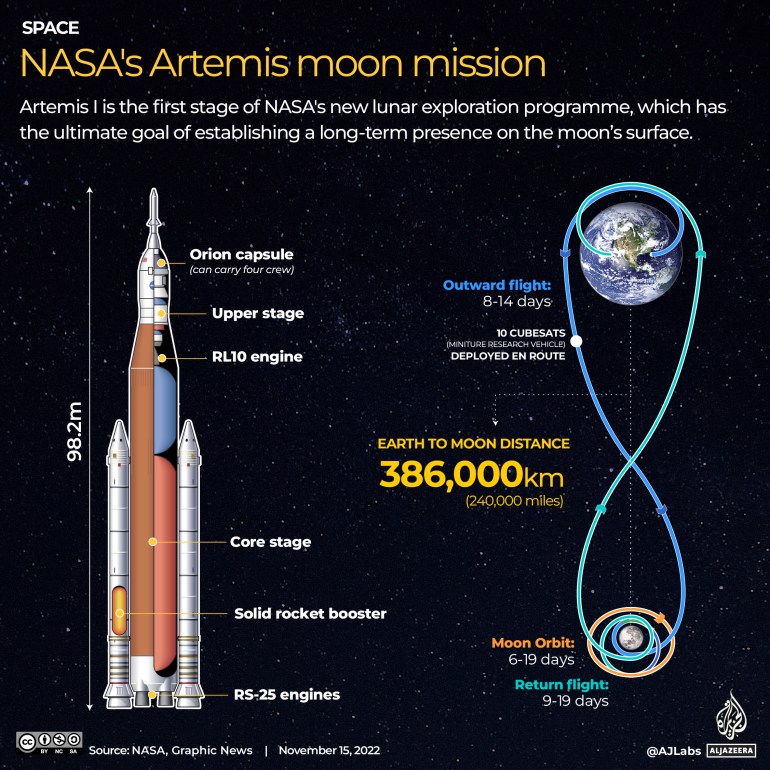
The first launch attempt, scheduled for August 29, was cancelled when one of the rocket’s four engines reported higher-than-normal temperatures, and NASA workers found a hydrogen leak. A second attempt, planned for September 3, was likewise scrapped due to a hydrogen leak.
In the weeks that followed, the launch was delayed as Hurricane Ian slammed the state. The rocket was already on the launch pad when Hurricane Nicole made landfall last week as a category-one storm just south of the Kennedy Space Center. But the rocket is designed to withstand 85mph (74.4 knot) winds.
A NASA inspection found insulation damage incurred during the storm but ruled that, even if the insulation should break away, it was unlikely to endanger the flight.
If all goes well with this mission, astronauts could strap in as soon as 2024 for a lap around the moon, with NASA aiming to land two people on the lunar surface by the end of 2025. NASA says its Artemis programme will put the first woman and the first person of colour on the moon.
Orion’s flight is supposed to last six weeks from its Florida liftoff to the Pacific splashdown. This extra-long mission – twice as long as astronaut trips – is designed to test and tax all systems.
It will take nearly a week to reach the moon, 386,000km (240,000 miles) away. After whipping closely around the moon, the capsule will use its gravity to swing out and enter a distant orbit with a far point of 61,000km (38,000 miles). That will put Orion 450,000km (280,000 miles) from Earth, farther than Apollo, which was at 400,727km (249,000 miles)
The big test comes at the mission’s end, as Orion hits the atmosphere at 40,000km/h (25,000mph) on its way to a splashdown in the Pacific. The speed of re-entry will generate an intense amount of heat, which will test the capsule’s heat shield.
The heat shield uses the same material as the Apollo capsules to withstand reentry temperatures of 2,750 degrees Celsius (5,000 degrees Fahrenheit).
But the advanced design anticipates faster, hotter returns by future Mars crews. The mission is supposed to be the first step towards a sustained programme of human exploration of the moon, Mars, and beyond, according to John Logsdon, a professor emeritus at the Space Policy Institute at George Washington University.
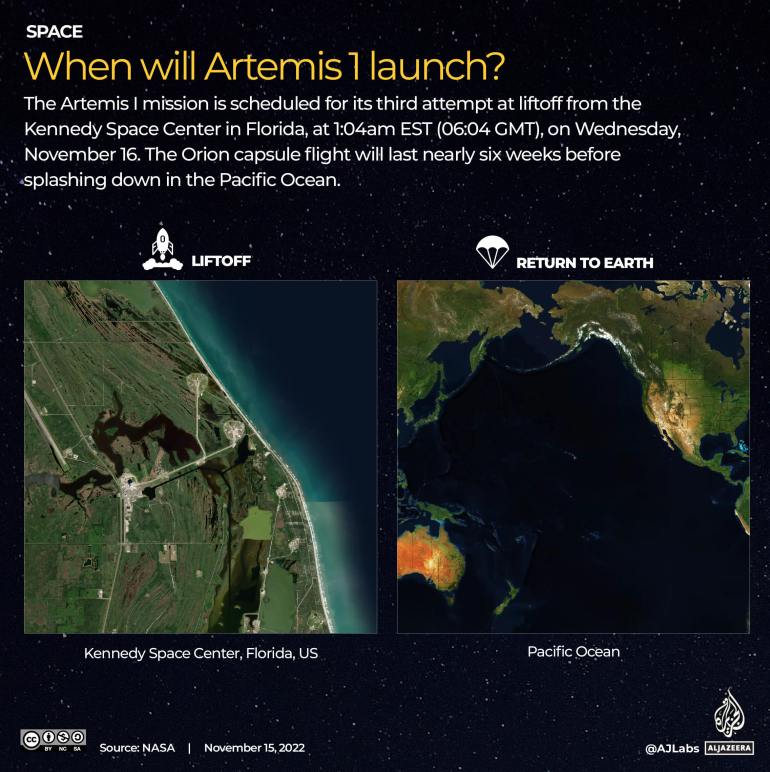
What is Artemis going to do?
According to NASA, it is “going back to the moon for scientific discovery, economic benefits, and inspiration for a new generation of explorers”.
Besides three test dummies, the flight has a slew of stowaways for deep space research.
Ten shoebox-sized satellites called CubeSats, carried inside the rocket, will pop off once Orion is hurtling towards the moon. They will conduct a range of science experiments and technology demonstrations in deep space.
The Orion will carry a few slivers of moon rocks collected by Apollo 11′s Neil Armstrong and Buzz Aldrin in 1969, and a bolt from one of their rocket engines, salvaged from the sea 10 years ago.
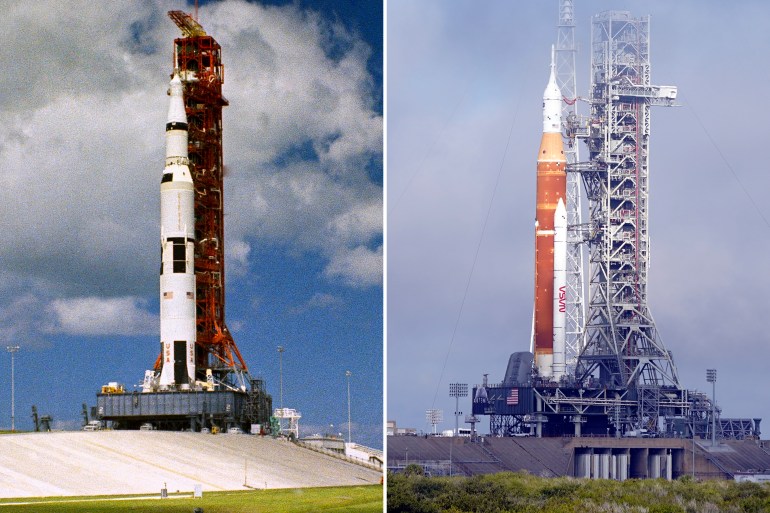
Previous moon missions
More than 50 years later, Apollo still stands as NASA’s greatest achievement.
Twelve Apollo astronauts walked on the moon from 1969 through 1972, staying no longer than three days at a time. For Artemis, NASA will be drawing from a diverse astronaut pool currently numbering 42, and it is extending the time crews will spend on the moon to at least a week.
Using 1960s technology, NASA took just eight years to go from launching its first astronaut, Alan Shepard, to landing Armstrong and Aldrin on the moon.
By contrast, Artemis, named after Apollo’s mythological twin sister, has already been in the works for more than 10 years and is estimated to cost $93bn by 2025.
Since 1958, there have been 70 successful and partially successful missions by six nations to the moon. A further 41 flights were not successful, according to NASA’s archive.
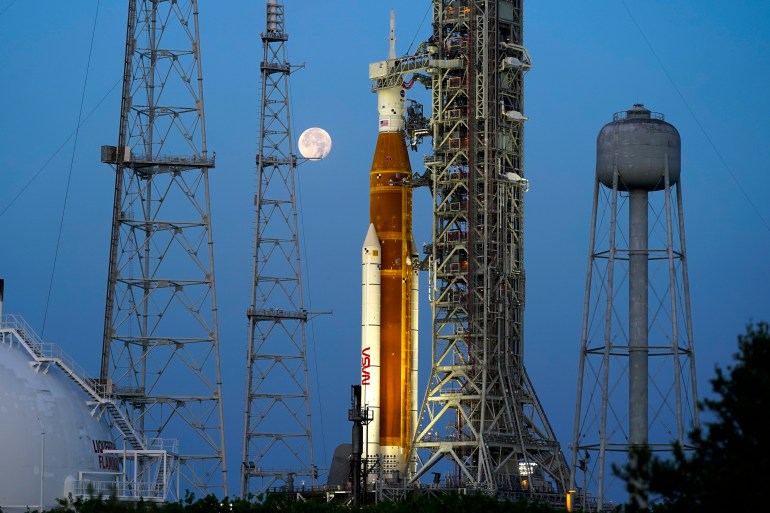
During the 1950s, 1960s and 1970s, the United States and USSR were the only countries that attempted missions to the moon. Between them, the two Cold War rivals attempted at least 90 moon missions, 40 of which were unsuccessful.
During the 1980s, no lunar missions were launched.
In 1990, Japan joined the space race with its Hiten Orbiter.
In the 2000s, China, India and the European Space Agency launched their first successful missions to the moon.
